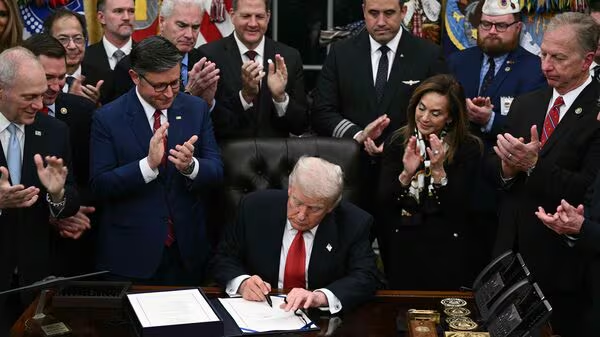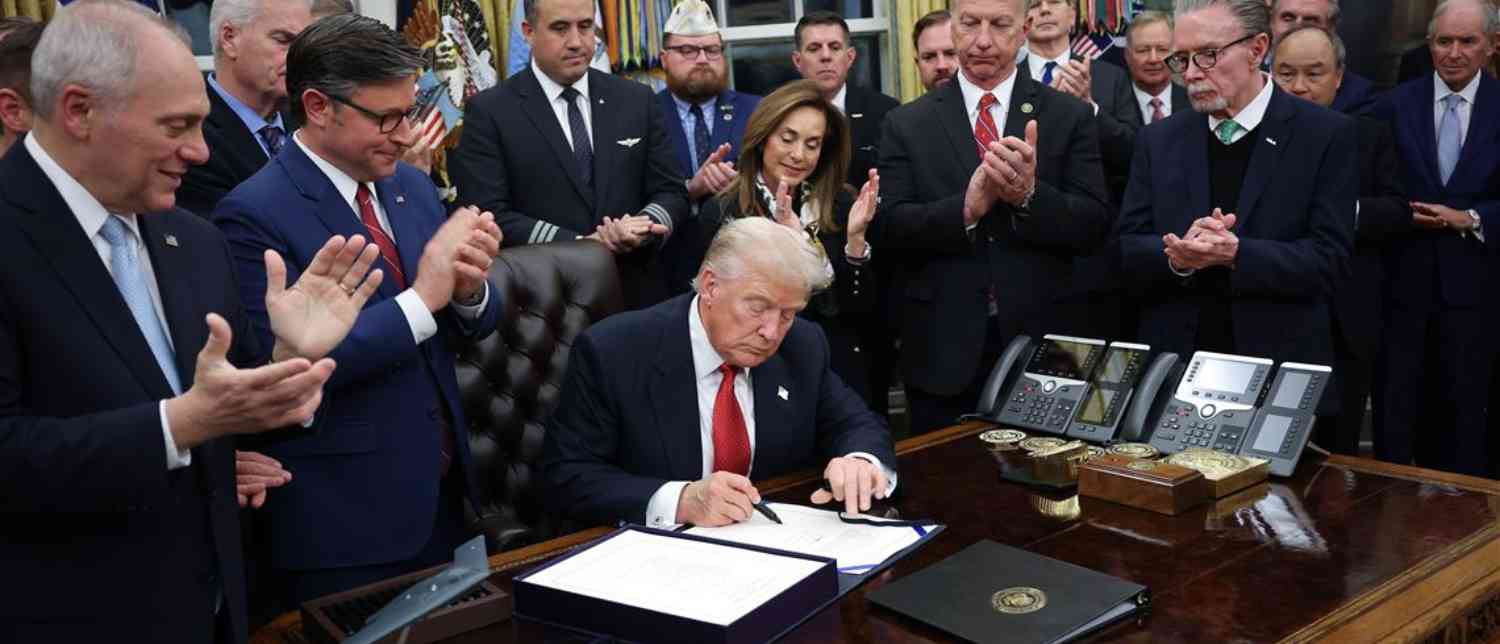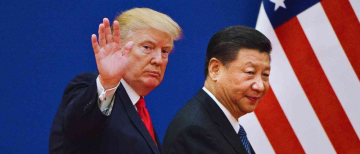In a significant political development, United States President Donald Trump signed a government funding bill on Wednesday night, officially ending the longest government shutdown in U.S. history. The 43-day shutdown had paralyzed key government operations, delayed salaries for thousands of federal employees, and created ripple effects across sectors—from aviation to public welfare.
The bill, which passed both chambers of Congress earlier this week, restores funding to federal agencies and ensures that affected workers can return to their jobs starting as early as Thursday. According to Reuters, the measure followed intense bipartisan negotiations and came after weeks of mounting public pressure over the economic and social toll of the prolonged closure.

“We Will Never Give in to Extortion,” Says Trump
Before signing the bill in the Oval Office, President Trump delivered a defiant message to lawmakers and the American public.
“Today we are sending a clear message that we will never give in to extortion,” he declared, drawing applause from Republican lawmakers gathered around him.
Moments later, he added, “It’s an honor now to sign this incredible bill, and get our country working again.”
The remarks reflected Trump’s determination to frame the end of the shutdown not as a political retreat but as a stand against what he described as partisan obstruction.
Congress Passes the Funding Bill After Weeks of Gridlock
The Republican-led House of Representatives approved the bill earlier in the day by a vote of 222–209, following the Senate’s approval on Monday. The legislation marks a temporary truce in a fierce standoff between Democrats and Republicans that had left millions of Americans caught in the crossfire.
The measure extends government funding through January 30, ensuring continued operation of federal agencies and services. However, it also means the government remains on track to add approximately $1.8 trillion in debt annually, contributing to the already staggering $38 trillion national debt.
The bill reverses the termination of federal employees that occurred during the shutdown and guarantees no further layoffs through January, ensuring that all affected employees will receive back pay.
President Trump signs bill to OFFICIALLY reopen the government, ending the Democrat Shutdown.
Let's get our country WORKING again. 🇺🇸 pic.twitter.com/QJqX90k9sC— The White House (@WhiteHouse) November 13, 2025
Support for Essential Services and Security
Beyond restoring salaries and operations, the bill includes key allocations for public safety and welfare. The Agriculture Department will now be able to fund essential food assistance programs, ensuring that low-income families relying on benefits such as the Supplemental Nutrition Assistance Program (SNAP) will not face further disruptions.
According to the Associated Press, the package also includes $203.5 million to enhance security for lawmakers and an additional $28 million to safeguard Supreme Court justices amid heightened national tensions.
Financial and Human Costs of the 43-Day Shutdown
The six-week shutdown inflicted deep economic wounds and personal hardships across the country. Hundreds of thousands of federal workers went without pay, forcing many to dip into savings or rely on food banks.
Air travel was disrupted nationwide, with flight delays and cancellations as key aviation personnel were furloughed or overworked. Long lines at airports became a common sight, while transportation and public safety operations slowed down.
The Congressional Budget Office (CBO) estimated that the shutdown would result in a permanent loss of around $11 billion to the U.S. economy, even as much of the short-term damage could be recovered in the coming months.
But beyond numbers, the emotional and psychological strain on federal employees was profound. Many missed rent payments, struggled with utility bills, or relied on community support to stay afloat.

What Prompted the Shutdown?
The record-breaking shutdown stemmed from an impasse between Democrats and Republicans over a key funding issue tied to health care costs. Democrats refused to back a short-term spending bill unless it included an extension of an expanded tax credit that helps reduce the cost of health insurance purchased through Affordable Care Act (ACA) marketplaces.
This tax credit, originally enhanced during the COVID-19 pandemic and later reinforced by President Joe Biden’s energy and health care legislation, is set to expire at the end of December. Without renewal, the average insurance premiums for millions of Americans could more than double, with the CBO warning that over 2 million people risk losing coverage next year.
“Never have American families faced a situation where their health care costs are set to double — double in the blink of an eye,” said Senate Democratic Leader Chuck Schumer (D-N.Y.), emphasizing the urgency of extending the tax relief.
Republicans, however, maintained that a funding bill must first be passed before any policy discussions could occur. “Republicans are ready to sit down with Democrats just as soon as they stop holding the government hostage to their partisan demands,” stated Senate Majority Leader John Thune (R-S.D.).
The Impact on Ordinary Americans
While the political debate unfolded in Washington, ordinary Americans bore the brunt of the stalemate. Many federal employees missed multiple paychecks, while families relying on SNAP and other social programs faced uncertainty about their next meal.
Airports struggled with staff shortages, leading to long security lines and canceled flights, stranding thousands of travelers. In several cities, food banks reported record turnout, with furloughed workers joining low-income residents in line for essentials.
The shutdown also halted the release of critical economic data from government agencies, leaving economists and investors without key indicators for weeks. The disruption hampered everything from business planning to stock market forecasts.
Restoring Normalcy: What Happens Next?
With the bill now signed, federal agencies are expected to resume normal operations immediately. Workers will return to their posts as early as Thursday, bringing long-awaited relief to millions of households.
Reuters reported that the reopening of government services should allow air travel systems to stabilize just in time for the Thanksgiving rush, only two weeks away. The restoration of food aid programs could also help families regain some financial balance before the Christmas season.
Moreover, the return of economic data flow from federal statistical agencies will help restore confidence among investors and policymakers trying to gauge the health of the U.S. economy after weeks of uncertainty.
Global and Political Repercussions
Internationally, the shutdown raised questions about the reliability of the United States as a political and economic partner. Critics argued that prolonged domestic gridlock undermines U.S. credibility abroad.
“This dysfunction is damaging enough to our constituents and economy here at home, but it also sends a dangerous message to the watching world,” said Senator Jerry Moran (R-Kan.). “It demonstrates to our allies that we are an unreliable partner, and it signals to our adversaries that we can’t work together to meet even the most fundamental responsibilities of Congress.”
His remarks echoed growing bipartisan concern that the repeated threat of shutdowns—once a rare event—has become a recurring symptom of Washington’s deepening political polarization.
The Road Ahead
Although the shutdown has ended, the deal is temporary. The new bill only funds government operations through January 30, setting the stage for another potential standoff early next year if negotiations on long-term fiscal policy and healthcare subsidies remain unresolved.
Analysts warn that unless Congress reaches a durable compromise, the U.S. could face yet another round of fiscal instability in the months ahead. With the 2025 election cycle looming, both parties are eager to avoid another crisis that could alienate voters and further strain the economy.
For now, though, the signing of the bill marks a moment of relief—for workers returning to their offices, families regaining access to essential services, and an economy taking its first steps toward recovery after six weeks of uncertainty.
With inputs from agencies
Image Source: Multiple agencies
© Copyright 2025. All Rights Reserved. Powered by Vygr Media.
























